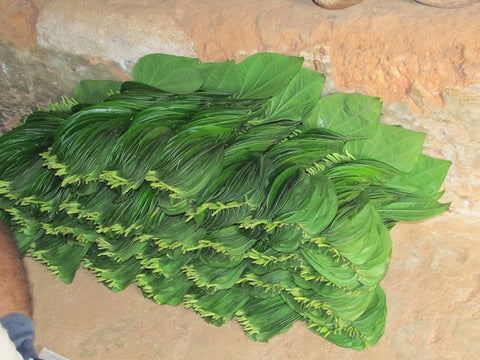Colours of Harvest October 15 2013
The endless variety of farm produce never ceases to amaze us. The first year that we were here was a real learning experience for us. We made countless ‘Farm-visits’ to well established farms to learn more about managing such a farm, browsed the net and read thru pages and pages of ‘Cultivation Manuals’ gleaned great information from the websites of the Spice Board of India, TamilNadu Agricultural University(TNAU) and so many others. We learnt to manoeuvre the long ‘Harvestor’ (which is a basket with a blade tied to the end of a pole) thru the branches and tug at the ripe fruit. It needs more skill and strength, than we imagine to neatly hook the fruit and pull it off without damaging the unripe ones near it. But we are slowly getting good at it.

The Harvestor at the end of a 15 feet long bamboo
The cashew needs to be plucked as soon as it ripens or else it falls to the ground where the fruit is eaten by the cows during the day or the wild boars at night. The nut which contains a very abrasive, acidic oil is slit open and eaten by the porcupines – probably the only animal who eats the cashewnut. Even the monkeys throw the nut, eating only the fruit. So apart from plucking the fruit from the trees, we have to check the ground below to pick the nuts. The fruit is then separated from the nuts. Bucket loads of the fruit which in Goa would have been converted to Feni, is given to the cows. Oh what joy to see them slurping and chomping on the juicy tidbits, they just love it!
The Cashew fruit with the nut on the outside
We learnt how to make Organic fertilizers like Jeevamrut and Panchgavya which have shown fantastic results – for instance we had four really tall Clove trees approx 17 years old. The Clove Cultivation Manual had stated that cloves buds appear on the trees in January and need to be harvested (hand-plucked) before they flower. Clove is valued only when it is dried in its bud stage and has the globular tip (remember Promise Toothpaste ads?). Of course we scarcely notice this when we dunk cloves into the frying pan while cooking. So well, the first year that we were here, the whole of January had me scanning the trees to see if flowers had appeared. No luck! Finally our farm hand Manjunath sheepishly admitted that these trees had never produced any cloves all these years. Well........ Anyway we kept up with the Jeevamrut and Panchagavya spray all through the year. And surprisingly this Jan we had a great harvest of cloves.
Clove buds just harvested
Sun drying the clove buds
The majority of the farm produce is harvested in the hot summer months, nature’s great timing at work so that we can sun dry most of the produce and store it for the whole year. So as you can imagine, the work multiplies multifold.

Fresh Kokum fruit
Kokums need to be cut open, the seeds extracted and the outer peels are sun dried. The pulp surrounding the seeds has a lot of juice which needs to be squeezed out. Each evening, the partially dried kokum peels are soaked back into this juice, to be squeezed out next morning and dried again. 4 to 5 days of this treatment and the kokum is ready to be stored in bottles. This method imparts a really rich lovely colour to the peels. The seeds are dried separately and used for making Kokum butter – a product which has been used since ages in India and is now gaining popularity in the western cosmetic world.
Basket loads of Vatamba
The ‘Vatamba’ , used as a souring agent , a fruit that I had never seen or heard of before, grows abundantly. The first time I saw it, our farm hand Manjunath explained that it needs to be sliced thin and then sundried. He had harvested a basketful and I took half of it to the kitchen. It was far tougher than I thought and by the time I finished slicing the pile, my hands were quite sore. I went back to the outhouse to see a staggering pile of harvested vatambas. How on earth was I going to slice all of these? But Manjunath was prepared with a very sharp traditional cutter ‘Adli’ and sliced his way through the pile merrily chomping on his betel leaf&nut mix.
All sliced and out in the sun
As for some of the other items that we get from the farm, see the pics below.

Nutmeg (Jaiphal) with its red, delicate outer aril which is the exotic spice Mace (Jai-patri)

Nutmeg and Mace being sundried
Stacks of freshly plucked Betel Leaves

The worlds largest 'Sprout' - Coconut sprout a rare delicacy. We were lucky to get a couple of these when the stored coconuts got drenched in a heavy shower resulting in some of them sprouting.







